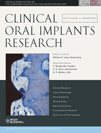Primary implant stability after maxillary sinus augmentation with autogenous mesenchymal stem cells: a biomechanical evaluation in rabbits
Abstract
Objectives: To mechanically evaluate the effect of transplantation of precultured preosteoblasts derived from autogenic adult mesenchymal stem cells (aMSC) for experimental sinus floor augmentation on primary dental implant stability in comparison with conventional augmentation procedures in rabbits.
Material and methods: After experimental sinus floor augmentation with a synthetic bone substitute, autogenous bone transplantation or osteoblast precursor cells, the primary stability of implants inserted in the edentulous part of the upper jaw of New Zealand White Rabbits was examined. Mechanical evaluation was performed by determination of insertion torque values (Osseocare™), percussion testing (Periotest™), resonance frequency analysis (Osstell™ and scanning laser Doppler vibrometer) and measurement of extraction forces.
Results: Evaluation of mechanical properties with percussion testing and resonance frequency analysis with Osstell™ revealed slightly higher primary stability of the stem cell group whereas the scanning laser Doppler vibrometer and measurement of pull-out forces showed no significant difference to the bone substitute group. Transplantation of autogenous bone graft resulted in the highest primary implant stability.
Conclusions: The three examination modalities proved suitable for the determination of primary implant stability. The experimental maxillary sinus floor augmentation with precultured osteoblast precursor cells from autogenic stems cells clearly enhanced the primary stability of implants compared with the unaugmented sinus and lead to comparable primary mechanical properties to bone substitutes in rabbits. In comparison with the autogenous bone graft stability enhancement by stem cell transplantation declined.
To cite this article: Riecke B, Heiland M, Hothan A, Morlock M, Amling M, Blake FAS. Primary implant stability after maxillary sinus augmentation with autogenous mesenchymal stem cells – biomechanical evaluation in rabbits.Clin. Oral Impl. Res. 22, 2011; 1242–1246.doi: 10.1111/j.1600-0501.2010.02043.x




